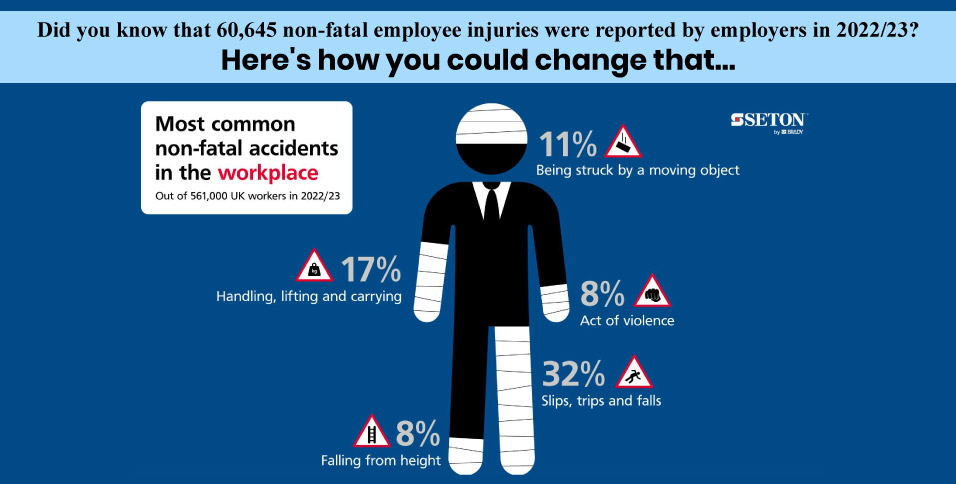Yes, you read that right. In the year of 2022/23, there were 60,645 non-fatal employee injuries reported by employers. 561,000 employees self-reported that they sustained non-fatal injuries.
These workplace injuries include slips, trips, and falls, alongside handling, lifting and carrying, and more. But, how can these staggering numbers be lowered?
Whether they’re warehouse hazards or office hazards, let’s take a look at how to make the workplace a safer place for all employees…
The solutions:
32% of non-fatal workplace injuries are caused by slips, trips, and falls. Hazards like moving objects and falling items can be more challenging to prevent, but the simple use of safety signs can reduce this.
Simple precautionary measures, such as placing wet floor signs near freshly mopped or spill-prone areas, can alert employees to potential slip hazards. Similarly, signs indicating potential trip hazards can help employees navigate their surroundings safely, reducing the likelihood of falls, and the ripple effect of workplace injuries.
But what else could change this and reduce the number of non-fatal employee injuries?
Ensuring a safe working environment and minimizing work-related injuries requires a proactive approach from both employers and employees. Here are some effective measures that can be implemented:
- Maintaining tidy areas
Keeping up with good housekeeping practices and maintaining a tidy workplace is crucial for preventing accidents. Having a spill-cleaning kit readily available allows for a prompt response to spills and leaks, preventing hazards from appearing.
Clearing obstacles that might be in the way, covering cables, signposting uneven surfaces, and using shadow boards to organise and store equipment can help mitigate common causes of workplace accidents.
- Training
Training is one of the most important factors in reducing workplace accidents, as it provides you with the knowledge needed to prevent issues.
It equips all staff members with the necessary knowledge and skills to effectively identify and mitigate workplace risks. Refresher training, especially for repetitive tasks such as understanding signs and operating machinery safely, is highly beneficial in reinforcing safe practices.
- Proper safety signage
Employers have to provide clear safety signs when significant risks cannot be avoided or controlled through other means, like if you’re awaiting cleaning products to clean a spillage.
Regular maintenance and correct placement of these signs, ensuring they are easily visible, is crucial for effectiveness. The colour coding of signs conveys specific messages: red prohibits certain actions, and black and yellow signify danger, caution, or warning, for example.
- Zone classification
This is another important step to take, especially in industries dealing with hazardous areas. If there is a risk of explosives, the space must follow ATEX zone classifications.
Zoning is also essential in warehouse settings to improve efficiency and appropriately manage hazards and risks due to it being a more dangerous place to work. Regular risk assessments are necessary to correctly classify and manage these zones to prevent the number of injured employees.
- Anti-slip matting
Slips, trips, and falls are among the most common causes of workplace injuries, so it’s especially wise for a workplace and its employees to know how to properly prevent them.
Installing anti-slip matting, anti-slip tape, and stair treads can help prevent such incidents. Proper entrance matting can also contribute to maintaining a clean and safe working environment by reducing the tracking of water or mud from outdoors – making for both a safe and clean working environment.
It’s clear that there are many ways to lower the number of non-fatal employee injuries using elements like safety signage and anti-slip matting. By the adoption of more of these tools, the number of these injuries will likely lower in years to come for a workplace where your employees can feel happier and safer.
Also Read: How to Use Workplace Safety Posters as a Tool for Employee Training and Education















